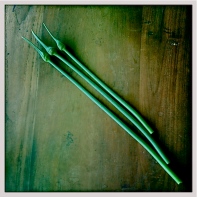Tayberries are a hybrid, first developed in 1962 by Derek Jennings, a botanist at the Scottish Horticultural research institute and David Mason, a fellow researcher. It wasn’t until 1979 that the Tayberry was commercially released. The hybrid was named after the Scottish River Tay.
The original tayberry is a cross between the Aurora blackberry and a polyploid Malling Sport Raspberry. There are of course many different types of Tayberry today. Even a thornless variety called Buckingham. We have two tayberry plants, bought a couple of seasons ago, and they a rather large and thorny variety. I don’t remember the actual variety, but they currently resemble an octopus. I often get snagged when passing them as their ‘tentacles’ blow around in the breeze. Which reminds me, I really must tie them up!
Tayberries are pretty easy to please; they’re not too fussy about soil type, providing it’s free draining. They prefer to be in full sun but will tolerate partial shade. Tayberries grow fairly large, so if space is an issue, it’s possible to have one plant because they are self-pollinating. These plants should remain productive for 15 to 20 years.
Tayberries grow like summer raspberries and blackberries; they are floricanes. Floricane means a plant stem that grows a year before it bears flowers or fruit. Tayberries don’t grow canes like raspberries but LONG bramble stems, up to 6 to 7 feet, much like a blackberry. Care is required when pruning. On our first season we accidently treated them like a primocane. Primocane means, plant stem that bears flowers and fruit on the first seasons growth. All stems were pruned down to about a foot from the ground and we ended up with about 20 berries the following season. There may not have been many berries but they made a rather delicious snack whilst pottering around the plot. So last year we didn’t prune them at all, and we have long stems covered with flowers this season.
The Tayberry produces a large cone shaped reddish-purple fruit. The fruit tastes divinely sweet and aromatic. They flower in April/May. Fruit should be ready to harvest from July to August depending on the weather conditions. Birds are rather partial to eating soft fruit, so after flowering it’s worth covering the plant with netting to protect your crop.
Tayberries are difficult to harvest commercially as the fruits are exceptionally soft when fully ripe. It’s very unlikely you will ever see tayberries for sale in the shops, but you may be lucky enough to find them at some farmers markets.
In terms of aftercare there are a few jobs that need to be attended to.
In the autumn, prune the stems that produced fruit and tie in the new seasons stems into supports. Tayberries can become a tangled octopussy mess if they are allowed to go ‘wild’! It’s also important to keep good airflow between the stems to help maintain a healthy plant.
In spring apply some well-rotted manure around the base of the plant. This will help retain moisture and give the plant some extra nutrition. Continue to tie in the growing stems into their supports.
In the summer, cover with netting to protect your crop from those pesky birds who will want to consume those delicious berries before you do! Pick the berries when ripe and eat as soon as possible. They are soft and don’t store particularly well. Enjoy fresh with vanilla ice cream or have them for breakfast, or make jam….. they can also be frozen, not that i can see that happening.



















Hi. I have had a Buckingham Tayberry for 3 years now, and last summer and this, it has produced flowers but never fruit. The flowers last year just withered and died. Like last years’, this years flowers are looking a bit ‘papery’ and flimsy, although I have never seen their flowers, so maybe that is just what they look like? Do you have any suggestions how I might encourage it to fruit? Or is it just a bad specimen and I need to think about getting another? Many thanks for any help you can give. Kind regards, Luisa
Hi Luisa. Goodness, that sounds very annoying and rather disappointing. I’m wondering if the flowers are getting pollinated. Have you seen bees or butterflies on the flowers? Without pollination you won’t get any fruit. It does seem very strange to get flowers but not fruit for three years in a row though….
I did a bit of a search online and it appears you are not alone with this problem. Someone in Edinburgh has experienced the same thing. No one had an answer for her either! The other thing it may be, if you live in a very cold area, if you experience a frost at the critical fruit formation period, around April time, this may impact fruit formation. Again, very unlucky to have that happen to you three years in a row.
Sorry not be much help to you but I will continue to investigate and I’ll let you know if I discover anything. I actually find it fascinating why this would happen. Emma
And thank you for reading my blog and leaving me a comment.